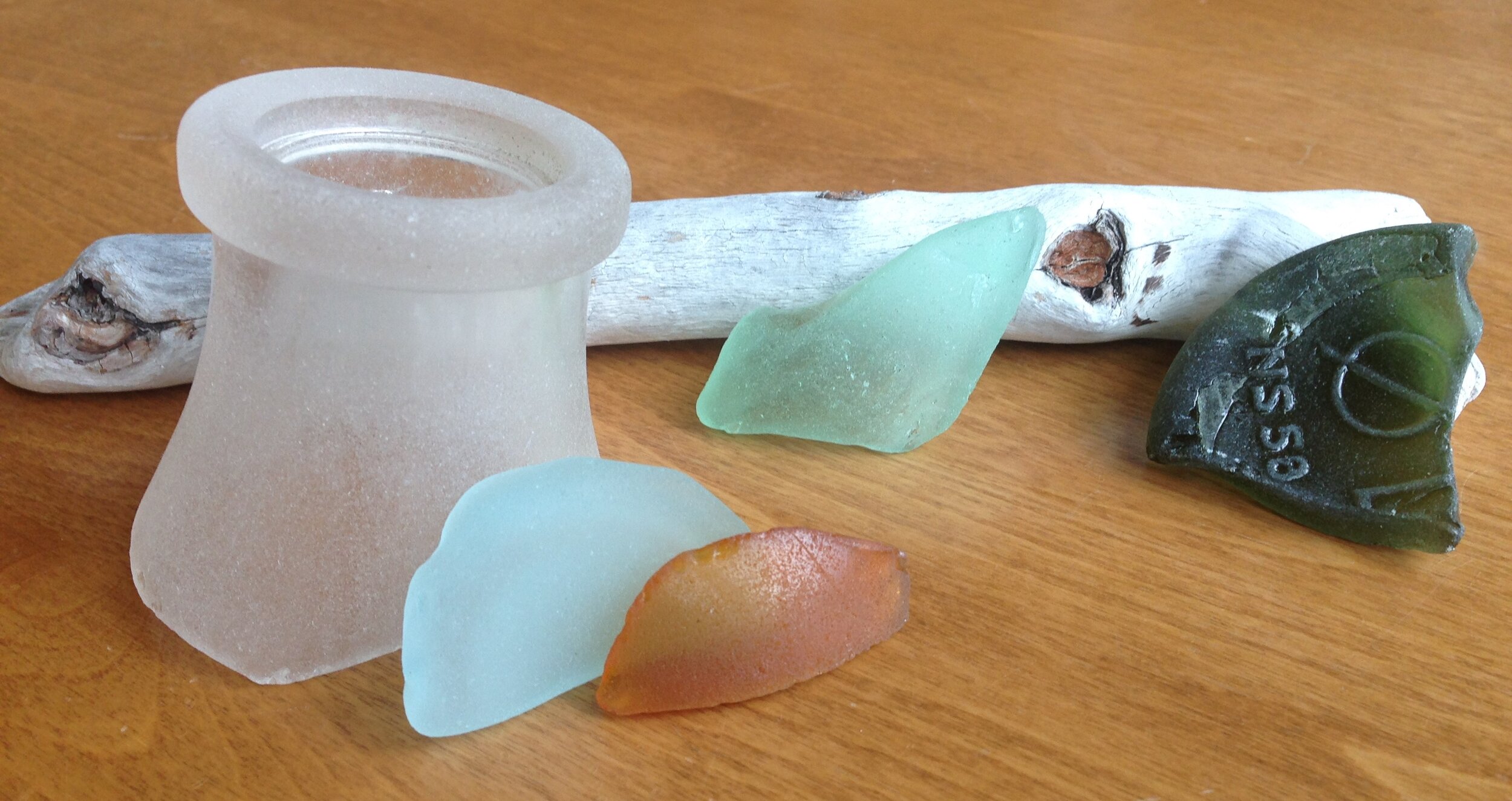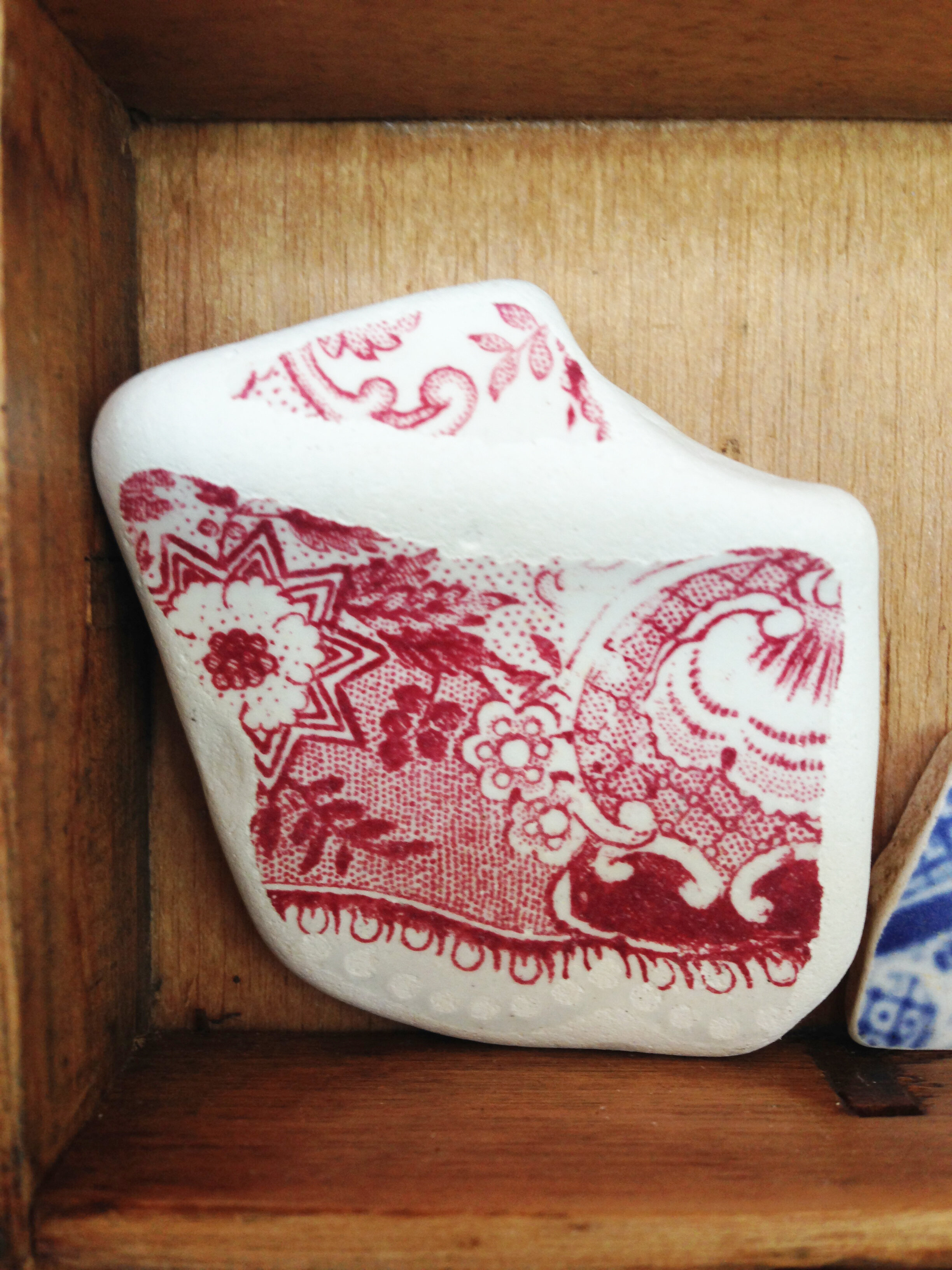Sea Glass: Tiny Treasures of the Sea
For more than 600 years, ocean pirates have been recorded in history as treasure-chasers. I like to think of sea glass as a tiny treasure of the sea. Not only can it be beautiful, it has a story to tell. Folks who know the nature of sea glass feel that it takes at least 50 years of tumbling in the ocean and tossing in the waves for sea glass to develop a really good, natural time-worn texture. When you pick up an interesting piece of sea glass, it begs you to contemplate its journey before it washed up on the shore and you found it (or did it find you?).
Sea glass can originate from bottles (including antique vessels from beverages, medicines, perfumes and other beauty products), and also from items such as marbles, dishes, windows, and ornamental items. Essentially anything made of glass that finds its way into the ocean and onto our beaches can become sea glass. The process of wearing down sharp glass and acquiring the matte finish takes decades. It is a result of the physical wear and tear of ocean waves tumbling and grinding the glass, as well as sandblasting as the glass gets buried in the sand and uncovered repeatedly throughout its journey. In addition to this physical weathering of the glass, there also is a component of chemical weathering caused by the seawater itself.
Of course, glass is made in a wide variety of colors. But the most common colors of sea glass to find are greens, browns and clear, due to the fact that more beverages were bottled in those colors. This makes other glass colors rarer if you are lucky enough to discover them – especially blue, red, purple or black.
Most pieces of sea glass you pick up have no markings. But some items you find on the beach do reveal a bit of their history. Bottles or other items might still show embossed or printed letters or numbers that can help to identify their sources. These can be clues to how old an item is, what company produced it, and maybe even a specific region where it was made. In addition to sea glass, you might also find other sea treasures along the shore, such as pottery shards or antique toys.
The red and white pottery shard is a piece of Transferware that I found on a beach in Cape May. Based on the shape, it was likely part of a dinner plate. This type of pottery was actually made by printing a design onto tissue paper, then transferring that pattern onto the pottery. Transferware was produced in many colors, predominantly in shades of blue, green, red and black. Most Transferware was made in England and was a very trendy style of pottery in the 1800s, becoming especially popular for use in the U.S. in the 1830s. Finding this piece made me very curious about its history. Exactly where did this particular item originate? What route did it travel to get to the spot where I picked it up, and how long did it take it to get here? Did it travel across the ocean from some other state, or even from Europe? Perhaps it was dinnerware purchased from England by one of the historic inns of Cape May, and then washed out to sea during a storm. Maybe it was taken from an inn to the beach by a couple enjoying an evening stroll on the boardwalk. It’s up to your imagine to decide.
Is it likely that your average piece of glass or pottery shard has monetary value? Most often the answer will be no. But value, like beauty, is in the eye of the beholder. Maybe you just like the color of a piece of glass or the way it reflects the light. Maybe it’s the feel of the surf-worn texture of it in your hand. Perhaps you display it in your home, and seeing it reminds you of the summer fun you enjoy on your visits to the shore. If you are crafty (or have crafty friends), you can even turn your found treasure into a piece of jewelry or art.


Of course, it is possible to find something truly unusual or rare. If you have a found item that you would like to have identified, it’s good to consult an expert. The North American Sea Glass Association (NASGA) hosts an annual festival that is held in different cities each year. This year we are lucky that it is returning to the Jersey Shore. The NASGA festival will take place on Oct. 27-28 at the Wildwoods Convention Center. A festival is a great place to see interesting items on display, and if you have a found item of your own that you’re curious about, you can have folks there take a look at it for you. This includes beach glass, pottery, and even small antique toys that have washed up on the beach. You can also draw inspiration from vendors there who have products for sale made from sea glass and pottery.
Now that your interest is piqued about finding glass at the shore, you should know that New Jersey actually has a long and fascinating history of glass production. The very first successful glass factory in the United States was located near Alloway in Salem County. At one time, dozens of glass factories dotted the landscape. In fact, South Jersey was home to more early glassworks than all regions in the country in the early 1800s. South Jersey had the perfect combination of ingredients to make glass production a success: oyster shells (for the lime they contain), salt hay (for packing material to transport the fragile glass), and nearby rivers to transport the products to large cities like Philadelphia and New York. The quality of southern New Jersey’s sand was crucial to establishing a glassmaking center. Sand is the major ingredient in glass, and it was such good, clean sand here that the South Jersey sand was exported to Massachusetts and as far away as Cuba. In fact, Davey’s Lake in the Higbee Beach Wildlife Management Area in Cape May is an old sand quarry for the export of sand for glass production.
If you’re looking for something unique to do on a rainy day, the Museum of American Glass at the Wheaton Arts and Cultural Center in Millville boasts the most extensive collection of glass produced in America. Wheaton Arts Center also has a hot glass studio with theater-style seating where you can observe resident artists display their craft of glass-blowing.
Not all treasures in life come with a map, and the journey is part of the experience. When you discover an interesting piece of glass or other item along the beach, it also sparks your imagination as to its origins, which can be educational as you use your sleuthing skills to research it. Keeping your eyes open for sea glass or other tiny treasures of the sea requires nothing more than tranquil walks on the beach while enjoying fresh salt air. Seems like a good dose of happiness in anyone’s day.
SUMMER NATURE PROGRAM
Spend a week discovering the New Jersey Shore in a fun and hands-on way! Engage in science experimentation and exploration, play games, go on field trips, explore the beach, create arts and crafts, and much more all while enjoying a new theme each week: Solar, Polar, Fire & Ice, Explore the Shore: Beneath the Shell, Get in Shape: Structures in Nature, Marine Micro Macro: Lifestyles of the Wet and Tidal, Nature of Night, Tagged, You’re It!, Herps and Terps, Common Ground, and Safari in the Saltmarsh!
For children ages 5-13, programs are held weekly from June 27-Aug. 22 and include field trips and beach days. Children age 4 can enjoy special programs during the weeks of June 27, July 9, July 23, Aug. 6 and Aug. 20. Children ages 4-5 attend programs daily from 9:30am to noon and children ages 6-13 attend programs daily from 9:30am to 2pm.
Summer 2018 Happenings
The Wetlands Institute is open daily from 9:30am-4:30pm with extended evening hours and activities until 7pm Tuesday-Thursday from June 12 to Labor Day!
Activities include:
Salt Marsh Safari
Creature Feature
Catch ‘o the Day
Hooked on Fishing and Crabbing at the Dock
Special Evening Happenings on Tuesday, Wednesday and Thursday evenings
Kayak and Paddleboard Back Bay Tours
Back Bay Birding and Wildlife Boat Tours
And more!
Visit wetlandsinstitute.org for a full schedule of daily activities and special events!




